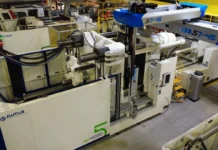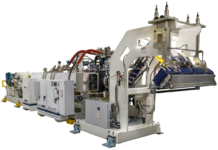Injection molding is a cost-effective way to produce parts, but there is often a significant amount of waste involved, from inefficiencies to user errors, machine damage and downtime, high scrap rates and more. Traverse City, Michigan-based RJG, Inc., offers seven ways to lower injection molding costs so companies can improve their bottom lines.
1. Reduce risk and cost of quality
The aspects of reducing risk and cost of quality are often reactive instead of proactive. This occurs because development of injection molding processes capable of handling unforeseen abnormal variation can be very difficult to predict. This exposes us to unplanned risk and expenses due to delivery of unacceptable parts.
There’s a better way. Begin by using scientific molding principles to develop a repeatable, robust process. After the process has been developed using sensors and technology, you can monitor for a wide variety of common defects in injection molding to ensure 100% quality to your customers.
How many times have we seen this scenario: A press has been running for weeks, and the process technicians are continuously making adjustments. Quality now alerts us to a defect on the parts, so we have to go adjust the process again to correct the defect, quarantine the suspect product and either sort, grind or rework the defective components.
In the worst-case scenario, we have shipped some of the components to the customer and have to alert them of the issue. The costs in this situation are numerous. By not developing and documenting a robust process based off of scientific molding principles, our technicians spend their valuable time adjusting the process to hopefully create a good part.
Once the defect is discovered, the technicians again are called to the press to correct the issue, and there is the uncertainty of whether the problem will reoccur. Now we have to figure out what to do with the product – sorting or reworking can take days or weeks and is rarely 100% effective. Not to mention, it is a non-value-added task, because we cannot inspect quality into the part.
If these parts have made it to the customer, the cost may be loss of business. This situation could have been avoided if we would have spent the time upfront to create and document a process that is repeatably capable of producing quality parts. Using in-cavity pressure sensors to monitor the process can add a higher level of control. Imagine knowing before the mold opens whether the part is good or bad and being able to sort that part automatically.
2. Increase efficiency through automation
With technology and training, you can automate several areas of production to help make the labor force more efficient. Part picking, part stacking and palletizing are three types of useful automations. Process control technology can allow for automated part sorting and alarms to let you know when a process is out of tolerance. This further improves efficiency and accuracy by providing data to allow you to determine the root causes faster without finger pointing. You’re able to stop troubleshooting and start trouble killing.
Think of processes in a facility without automation. Stepping through the process, we have to remove the part and runner system from the mold, organize the parts in order to be packaged, pack and then palletize the final product. Somewhere in that process, you may add an assembly step, which will add additional labor, floor space and time.
If these processes are done with manual labor, then there will always be a varying amount of efficiency in the process. If we focus just on removing the parts from the mold, even the most consistent operators will cause variation in cycle time, which leads to variation in part quality. This will be compounded through each step in the process.
As we begin to automate the process, we begin to remove the inconsistencies, increase efficiencies, improve quality, and increase available floor space. Automating quality—be it through process monitoring, vision systems or inline dimensional verification—can ensure that our customers never receive defective product again.
3. Increase awareness of process variance (reduce scrap)
By knowing immediately when variation has occurred in a process, you can fix problems sooner. That means less scrap, allowing for higher utilization of the available machine time and less money thrown in the trash. You can do this through process control software, cavity pressure monitoring and training.
In manufacturing, there is always an inherent cost of quality. This cost can be incurred on the back-end of production by using valuable resources and time to inspect parts before they can be shipped to the customer. The problem is that we never get a fixed cost of quality. As production varies, so does sorting time and the number of employees needed to sort product.
If employee turnover is an issue, an investment must be made in training new employees on sorting the defects. By ensuring all technical staff are trained to the same standard, you can be proactive in reducing or eliminating rejects rather than reactive and firefighting high scrap levels due to low skill levels and poorly set processes with small or non-existent process windows.
Another way to look at the cost of quality is on the front-end. By building quality into a process and monitoring the quality throughout the cycle, we are able to detect when process variation can occur. For example, if we know a material has a wide-ranging shift in viscosity that causes issues with quality, we can use process monitoring tools to detect a shift in viscosity. At this point, the process can be recentered to again make quality components.
4. Purchase wide specification resin
Resin that has more variation in properties is cheaper, but it can be difficult to validate or maintain dimensions with tight tolerance parts. This can increase variability and thus scrap rates, but if we use DECOUPLED MOLDING® techniques along with in-mold sensors, this can be a successful venture.
How many times have you seen this scenario: You are running good production for days, then all of a sudden, you begin seeing flash on parts. To fix the issue, the process technician reduces the fill speed. A few hours later, quality comes to you with short shots. Why all of a sudden were you running good parts then you instantly had flash? The answer is most likely viscosity.
Viscosity often can swing 30% in either direction, making it difficult to make a good part, even with a Decoupled II process. To ensure the same parts are being made every cycle (or at least as often as we can), cavity pressure sensors must be used to control the process and minimize the impacts of viscosity shifts in material.
5. Lower cycle time
You can utilize scientific molding and DECOUPLED MOLDING® techniques to optimize clamp/eject movements, fill time, pack time, hold time and cooling. You’re able to only use what’s needed to make good parts with a smaller buffer.
Properly sized mold temperature control units, or thermolators, also will help lower cycle times. Eighty percent of the molding cycle is spent cooling the part from the melt temperature to an ejection temperature where the part is rigid enough to withstand the forces of ejection and retain dimensional integrity. If we don’t have enough water flow, then the ability to cool the part to the correct temperature is compromised, and the work around is to leave the part in the mold longer, costing more money.
Evaluating the part thickness at the beginning of the project is the first step to determining cycle time. It’s important to question the thickness of the part and how it impacts the cycle time and part performance. Often, we find that the parts have been designed this way because “that’s the way we have always done it.” As you can imagine, this can be very costly. Science and simulation help predict design success, so we no longer need to build and test to get results. Ensuring proper part design is just one example of how you can lower your overall cycle time.
6. Build more efficient molds
Simply put, a mold is a pressure vessel and a heat exchanger — there will always be a pressure loss inside the cavity. However, in most cases, the lower the pressure loss is from post gate to end of cavity, the less likely we are to have quality issues like warp, voids, sinks, short shots, or dimensional variation.
To make plastic flow we need to heat, but to eject we need to remove some of that heat. To build an effective mold, it’s vital to ensure the water lines are placed in the correct location. We also need to select a metal that transfers heat well but can also withstand the material (specifically material with glass or carbon fiber filler). Lastly, the process must be set up with turbulent water flow to ensure the mold can reach thermal stability quickly and maintain that stability throughout a long production run.
You also can improve mold efficiency by increasing cavitation. One-cavity molds provide the least amount of variability, however the price to make a single part at a time is extremely high. If you can go to a higher cavitation, you can make more parts in the same amount of time. There are limitations on how many cavities you can have, including quality, mold and machine spacing, and validation requirements.
Another way to improve mold efficiency is to build family molds, which include different part geometries in the same mold. This can be extremely difficult, because the four plastic variables differ within each cavity. With process control software and in-mold sensors, however, you can use valve gates to control each cavity independently.
7. Reduce mold transfer costs
Process development applications ensure you can quickly and easily transfer a mold from one machine to another. Machine-specific set-up sheets are automatically generated when the mold is transferred, so you can make good parts from the first shot. Those curves can be used in any machine as long as the machine is capable of providing adequate flow rate, pressures, temperatures and volumes. Or, if simulation is not used, we can generate templates and transfer those to any capable machine.
Save time, energy, and resources by not having to create your own unregulated conversion tools or recreating the process from scratch for each new machine.





